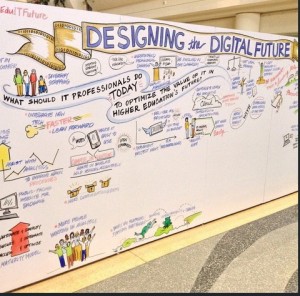
I was at the edX Global Forum last week. This is a meeting attended by faculty and staff from edX member institutions. This was my second one and the number of attendees and the diversity of institutions they represent have grown tremendously. It was great to meet several new people, including several from edX with whom I have only had phone contact. Because of our early start and the fact that we have completed four courses through WellesleyX, many attendees were eager to talk to me about our experiences.
Of all the talks and sessions I attended, the best was a student panel. Nine students from MIT, BU and Wellesley (may be Harvard also) who have taken “blended” classes discussed their experiences. Wellesley student Sharvari Johari is seated fourth from the left in the picture. She did a terrific job as a panelist. In almost all the courses these students took, their faculty taught a face to face class and was either teaching the same course at the same time on edX or had used an archived edX course that the faculty member had taught before. It was refreshing to hear directly from them for a variety of reasons, primarily because they are not afraid to express their opinions.
They liked the experience overall
All the students liked several aspects of the blended experience. The most liked aspects of the blended experience was the availability of the materials outside the classroom and the “stress free” assessment. Seven of the nine students are STEM majors and the courses that they took had assessments that are multiple choice questions which allowed multiple tries and provided a detailed answers that they could look up after completing the assessment. One of them mentioned how the stress of having to get the correct answer in a given period of time is a bit too much and many a times one is penalized for making silly numerical mistakes. Whereas in this medium, the focus is on learning. If you made a mistake, the explanation provided helps guide you to do it right the next time around.

 After a brief visit to
After a brief visit to